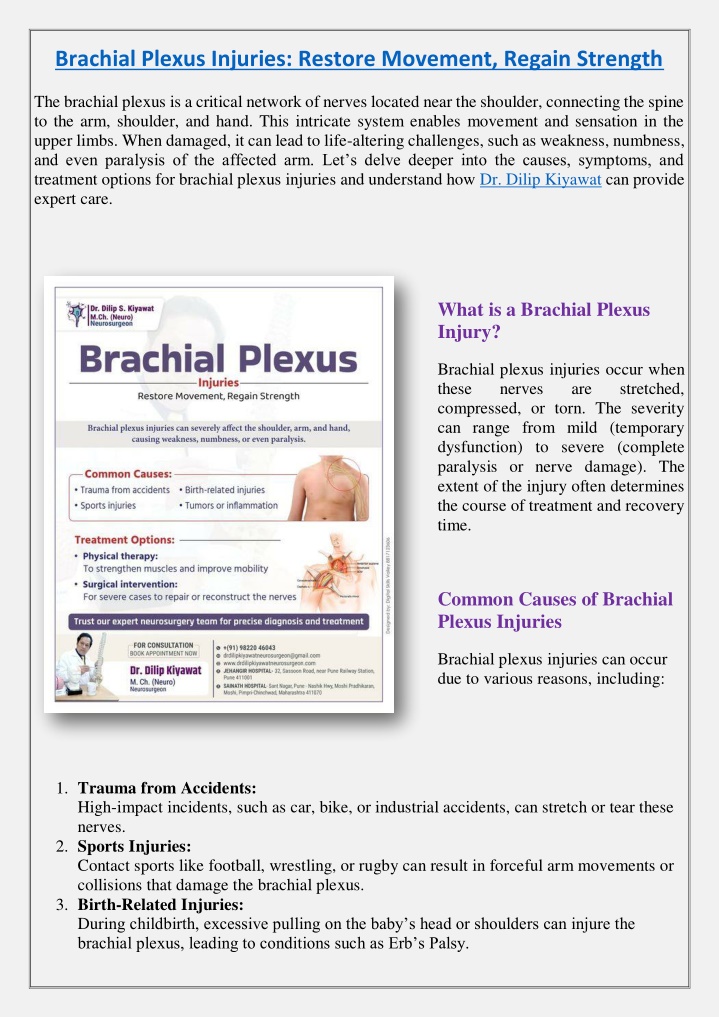
Brachial Plexus Injuries treatement in Pune - Dr. Dilip Diyawat
Dr. Dilip Kiyawat, a leading neurosurgeon in Pune, specializes in treating Brachial Plexus injuries. These injuries, caused by accidents, sports, or birth trauma, can lead to weakness, numbness, or paralysis in the shoulder, arm, and hand. With advan
Download Presentation

Please find below an Image/Link to download the presentation.
The content on the website is provided AS IS for your information and personal use only. It may not be sold, licensed, or shared on other websites without obtaining consent from the author. If you encounter any issues during the download, it is possible that the publisher has removed the file from their server.
You are allowed to download the files provided on this website for personal or commercial use, subject to the condition that they are used lawfully. All files are the property of their respective owners.
The content on the website is provided AS IS for your information and personal use only. It may not be sold, licensed, or shared on other websites without obtaining consent from the author.
E N D
Presentation Transcript
Brachial Plexus Injuries: Restore Movement, Regain Strength The brachial plexus is a critical network of nerves located near the shoulder, connecting the spine to the arm, shoulder, and hand. This intricate system enables movement and sensation in the upper limbs. When damaged, it can lead to life-altering challenges, such as weakness, numbness, and even paralysis of the affected arm. Let s delve deeper into the causes, symptoms, and treatment options for brachial plexus injuries and understand how Dr. Dilip Kiyawat can provide expert care. What is a Brachial Plexus Injury? Brachial plexus injuries occur when these nerves compressed, or torn. The severity can range from mild (temporary dysfunction) to severe (complete paralysis or nerve damage). The extent of the injury often determines the course of treatment and recovery time. are stretched, Common Causes of Brachial Plexus Injuries Brachial plexus injuries can occur due to various reasons, including: 1.Trauma from Accidents: High-impact incidents, such as car, bike, or industrial accidents, can stretch or tear these nerves. 2.Sports Injuries: Contact sports like football, wrestling, or rugby can result in forceful arm movements or collisions that damage the brachial plexus. 3.Birth-Related Injuries: During childbirth, excessive pulling on the baby s head or shoulders can injure the brachial plexus, leading to conditions such as Erb s Palsy.
4.Tumors or Inflammation: Tumors near the brachial plexus or inflammatory conditions can compress the nerves, causing functional impairment. Symptoms of Brachial Plexus Injuries The symptoms vary based on the severity and type of injury. Common signs include: Weakness or inability to use the shoulder, arm, or hand. Numbness or a tingling sensation in the arm. Severe pain in the shoulder or arm, often exacerbated by movement. Complete or partial paralysis of the arm. Loss of sensation or abnormal sensations in the arm or hand. These symptoms can profoundly impact daily life, making timely diagnosis and treatment essential. Treatment Options for Brachial Plexus Injuries Modern medicine offers various treatment approaches to address brachial plexus injuries. Treatment plans are designed based on the severity of the injury and individual patient needs. 1.Non-Surgical Treatments: oPhysical Therapy: Physical therapy plays a crucial role in strengthening muscles, improving mobility, and restoring basic functionality. Therapists design targeted exercises to gradually regain strength in the affected area. oPain Management: For patients experiencing chronic pain, medications or nerve blocks may be used to alleviate discomfort. 2.Surgical Intervention: oSurgery becomes necessary when the nerve damage is severe, such as in cases where the nerve is torn or severed. oNerve Repair or Grafting: Torn nerves are surgically repaired or replaced with nerve grafts to restore continuity and functionality. oNerve Transfers: In cases where the original nerve is irreparable, surgeons transfer functional nerves from other parts of the body to restore movement and sensation. oTendon Transfers: For restoring specific movements, tendons may be relocated from other areas to compensate for the damaged nerve. oAdvanced microsurgical techniques are used to ensure precise reconnection of nerves, improving the chances of recovery.
Recovery and Rehabilitation Recovery from brachial plexus injuries requires patience and perseverance. While some minor injuries heal on their own, more severe cases may take months or even years to recover fully. Post-surgical rehabilitation, including physical therapy and regular follow-ups, is essential to maximize recovery. Why Choose Dr. Dilip Kiyawat for Brachial Plexus Treatment? Dr. Dilip Kiyawat, M.Ch. (Neuro), is a highly experienced and reputed neurosurgeon specializing in the diagnosis and treatment of brachial plexus injuries. With years of expertise and a patient-centric approach, Dr. Kiyawat is dedicated to restoring his patients' mobility and quality of life. What Sets Dr. Kiyawat Apart? Expertise in advanced microsurgical procedures for nerve repair and reconstruction. Personalized treatment plans tailored to each patient s condition and lifestyle. A compassionate and supportive approach to ensure optimal recovery.
Consultation Details Take the first step toward recovery by consulting Dr. Dilip Kiyawat. Contact Information: Phone: +91 9822046043 Email: drdilipkiyawatneurosurgeon@gmail.com Website: https://drdilipkiyawatneurosurgeon.com/ Clinic Locations: 1.Jehangir Hospital Address: 32, Sasoon Rd, opposite Railway Station, Central Excise Colony, Sangamvadi, Pune, Maharashtra 411001 2.Sanjivani Hospital Address: Moshi Pradhikaran, Nashik Highway, Moshi, Maharashtra 411070 Trust the Experts Brachial plexus injuries can be life-altering, but with timely and expert care, you can regain movement, strength, and confidence. Dr. Dilip Kiyawat and his team provide state-of-the-art treatment, combining advanced techniques with compassionate care to ensure the best possible outcomes. Take charge of your recovery journey today reach out to Dr. Dilip Kiyawat and let him guide you back to an active and fulfilling life.






















